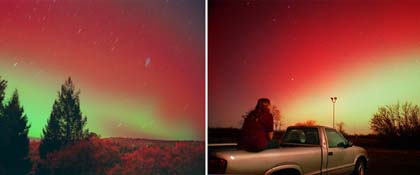
Left: Tony and Daphne Hallas photographed Monday night's brilliant aurora from Foresthill, California. Right: Kansas amateurs Vic and Jen Winter captured the northern lights from Bonner Springs.
The Sun's current sunspot cycle may be on the decline
but our nearest star still continues to pack a lot of punch — to
the delight of aurora watchers worldwide. At 16:20 Universal Time on
Sunday, November 4th, a powerful X-class flare unleashed a fast-moving
coronal mass ejection. This gust of ionized solar wind impacted Earth's
magnetosphere on Monday night, triggering a geomagnetic storm and a
display of northern lights reaching as far south as Georgia, Texas,
and California. In the Southern Hemisphere, the corresponding displays
of southern lights awed skygazers in New Zealand and elsewhere.
An indication of the geomagnetic storm's intensity are
the vivid colors of the auroral displays. Auroras typically cast a greenish
glow, the light emitted by oxygen atoms high in the upper atmosphere
after they are bombarded by electrons from Earth's magnetosphere. Monday
night's displays also exhibited rarer blood-red colors, which sometimes
involve ionized nitrogen molecules lower down in the atmosphere.
Jen Winter, observing from a relatively dark site in Bonner
Springs, Kansas, with her husband, Vic, and several members of their
local astronomy club, saw a giant arch of pale green, almost like a
rainbow, over the trees to the north. "The Moon was starting to creep
up on the eastern horizon," she reports, "but it was no match for the
aurora's crimson patches. At times the red glow reached Cygnus, but
other times the red was nearly gone, leaving only green. We needed the
whole horizon to catch all of the display, which appeared, faded, and
then reappeared."
Sky & Telescope contributing photographer
Tony Hallas was on his way to his backyard observatory in Foresthill,
California, at around 6:45 p.m. local time when he noticed the red glow
to the northeast. "White shafts of light could be seen during this time,"
he says. "At 7:15 p.m. the green display began. The sky to the northeast
became very bright red on top and green underneath. A large section
of the green broke off from the main body and traveled northward along
the horizon. The aurora was so bright it illuminated the surrounding
forest! By 8 p.m. the show was subsiding. Then 15 minutes later there
was a new burst of activity, with bigger and more pronounced white shafts
of light. This slowly tapered off, leaving only a diffuse red glow till
the Moon rose at around 9 p.m. Even at midnight, through strong moonlight
and some thin clouds, I could still detect the red glow to the northeast."
 0
0
Comments
You must be logged in to post a comment.